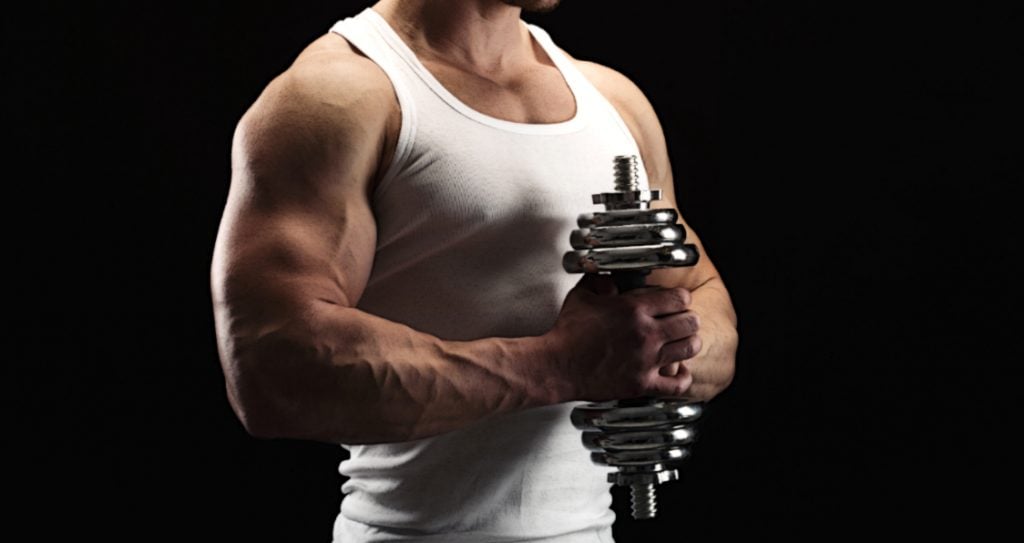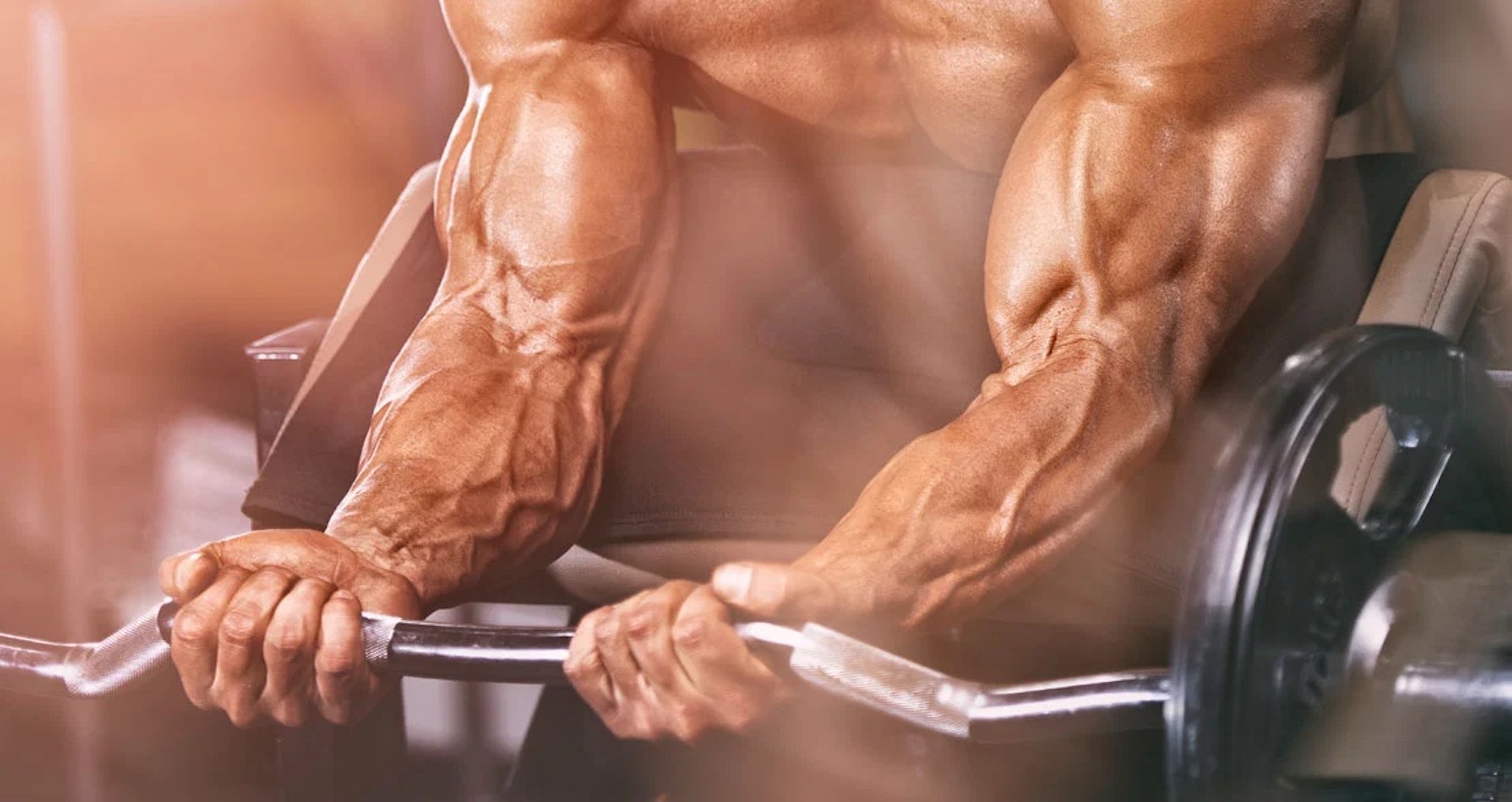Building The Forearms for Fuller Looking Arms
When looking to build significant muscle mass, training tends to focus on developing large muscles groups such as the glutes and quads, lats, pecs and delts.
While the arms do often receive a lot of attention too, the focus is predominantly on the muscles of the upper arm – the biceps and triceps.
As a result, the forearms can be neglected and therefore can under-develop in comparison to other areas.
It is important to build size and definition in the forearms in order to develop full-looking arms that matches your overall physique.
The general approach to forearm building is to concentrate on forearm isolation exercises for the forearm flexors and extensors – exercises such as wrist curls.
While these types of exercises can certainly allow for forearm growth, there are a number of other methods that can be employed to accelerate the rate of development.
The 7 Tips For Big Forearms
If you are serious about building size in the forearms, adopt a number of the following 7 tips and look to incorporate them into your training program.
1) Ditch the Straps
Wrist straps can be an excellent training tool which eliminate the detrimental impact of failing grip strength by securing the bar to the hands (1).
With exercise like the deadlift, failing grip strength can cause the individual to cease exercising before they reach absolute muscular failure.
Adding wrist straps will provide a much securing grip on the bar and allow the performer to work through to muscular failure without the grip slackening and failing.
However, when it comes to building size in the forearms, leave the straps in the locker room.
During all pulling exercises, you hold the bar by wrapping the fingers and thumbs tightly around the equipment your using, otherwise it will fall out of your grasp.
The extrinsic muscles of the forearms must work hard to maintain a secure grip throughout the duration of the exercise (2). Over time, these muscles will improve in strength and increase in size.
Furthermore, the heavier the load lifted, the more the forearms flexors must engage. Therefore, when lifting heavy, forget using straps in order to get maximize forearm activation.
There are a number of common pulling exercises that are excellent for forearm development and grip strength – exercises such as the deadlift, barbell row, and chin-ups.
Pushing exercises, such as the bench press and overhead press, are also effective forearm extensor developers – however, pulling exercises are superior for forearm engagement.
2) Grip Hard
Leading on from the last tip, it may be the case that you want to work the forearms but do not want to forgo using wrist straps.
This is absolutely fine. It is still possible to work the forearms effectively while still using the straps.
Here are two methods that are particularly useful for really pumping up the forearms.
Grab a barbell, place it on a power rack and load it up. Grip tightly and look to hold it at arms length for approximately 30 – 60 seconds.
It is also possible to this with dumbbells too. Select two heavy dumbbells, secure your grip and hold, again for 30 – 60 seconds.
Look to repeat this 8-10 times to really get the forearms burning.
3) Utilize Cables
As mentioned earlier, one of the most common forearm exercises is the wrist curl and reverse wrist curl. Barbells and dumbbells are most frequently used with this exercise.
However, the cables may be a better choice when it comes to wrist curls. This is because the cables maintain tension throughout the entirety of the movement.
This places an even greater demand on the wrist flexors and extensors and which may lead to a more efficient development of the forearms.
For the cable wrist curl, attach a short bar to the cable and adjust the pulley to the lowest position. Using D rings for this exercise is also acceptable.
In a kneeling position, place the forearms on the knees and use the thighs like a preacher bench. If preferred, set up a preacher bench in front of the cable machine instead.
Focus on flexing and extending the wrist only and perform the prescribed number of reps. It may be of greater benefit to focus on one wrist at a time rather than both simultaneously.
4) Go Old-School
You don’t need the latest fitness equipment to work the forearms effectively. In fact, there are a number of excellent forearm exercises that use basic kit.
One of the simplest exercises uses a dowel and a length of string. Insert the string through dowel, attach a weight to the string and the look to turn the dowel round and round to bring the weight up.
Once the weight has risen up to the dowel, unravel the string by gradually turning the dowel back and lowering the weight to the floor once again.
The hand gripper is another example of another basic piece of forearm developing kit. You can buy hand grippers with a range of grades.
Some take 60 pounds of pressure to close whereas others can be as high as 360 pounds of pressure! Be aware, this exercise is a lot more challenging than it looks.
5) Increase Wrist Training Frequency
The forearms are made up of dense muscle tissue which can be a little more resistant to change. Therefore, training them more often is crucial to facilitate size improvements.
Furthermore, research indicates that one of the most effective methods of promoting muscular hypertrophy is to increase the frequency of training (3).
Therefore, if looking to accelerate forearm hypertrophy, consider performing forearm orientated exercises more regularly – perhaps as much as every second day.
Be careful not to schedule forearms into your training the day before performing back and biceps. Having sore forearms when performing pulling exercises may negatively impact your performance.
6) Use a High Rep Scheme
Typically, for hypertrophy, a rep range of 6-12 reps will suffice. However, for forearm training, it is recommended to aim a lot higher than that.
Aim to complete high rep sets with a minimum of 15 reps. Feel free to experiment with rep ranges utilizing anything between 15 – 50 reps per set.
Many individuals believe that completing high reps does not positively impact the rate of muscle growth. However, high reps have been found to be beneficial when it comes to hypertrophy (4).
7) Consider Loaded Carries
Finally, it may be worthwhile adding in heavy carry exercises into your training – exercises such as the dumbbell farmers walk.
Not only will these type of exercises place a great demand on your grip strength and forearms, they are also very simple to set-up and execute.
For the dumbbell farmers walk, all that is required is a clear space and a heavy load. Simply pick up the load and take a number of steps forward while keeping the weight tight to the body.
Keeping going until the grip gives in and forces you to stop. Over time, gradually add more load to continuously challenge the forearms and force them to adapt.
Final Word
While wrist isolation exercises are very useful for developing forearm size and strength, there are a number of other strategies that can be adopted to bring about substantial growth.
Consider utilizing a number of the aforementioned forearm tips to your training, train hard, be consistent and over time, the forearms will noticeably grow causing the arms to look comprehensively bigger and fuller.
For more news and updates, follow Generation Iron on Facebook, Twitter, and Instagram.
References:
1-Coswig, Victor S.; Machado Freitas, Diogo Felipe; Gentil, Paulo; Fukuda, David H.; Del Vecchio, Fabrício Boscolo (2015-12). “Kinematics and Kinetics of Multiple Sets Using Lifting Straps During Deadlift Training”. Journal of Strength and Conditioning Research. 29 (12): 3399–3404. doi:10.1519/JSC.0000000000000986. ISSN 1533-4287. PMID 26595133
2-Mitchell, Brittney; Whited, Lacey (2019), “Anatomy, Shoulder and Upper Limb, Forearm Muscles”, StatPearls, StatPearls Publishing, PMID 30725660
3-Ochi, Eisuke; Maruo, Masataka; Tsuchiya, Yosuke; Ishii, Naokata; Miura, Koji; Sasaki, Kazushige (July 2, 2018). “Higher Training Frequency Is Important for Gaining Muscular Strength Under Volume-Matched Training”. Frontiers in Physiology. 9. doi:10.3389/fphys.2018.00744. ISSN 1664-042X. PMC 6036131. PMID 30013480.
4-pubmeddev. “Effects of Low- vs. High-Load Resistance Training on Muscle Strength and Hypertrophy in Well-Trained Men. – PubMed – NCBI”. www.ncbi.nlm.nih.gov.











